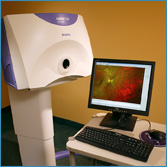|
Does Your Child Have A Learning Related Problem?
A large part of learning is done visually. Reading, spelling, writing, chalkboard work, and in many schools, computers, are among
the tasks students tackle all day long, day after day. Each involves the visual abilities of seeing quickly and understanding
visual information frequently less than arm's length from the eyes.
Many students' visual abilities just aren't up to the level of the demands of these types of learning situations in the
classroom.
Clear eyesight isn't all that's required for these close vision tasks. Youngsters must have a variety of scanning, focusing and
visual coordination skills for learning and for getting meaning from reading. If these visual skills have not been developed, or
are poorly developed, learning is difficult and stressful, and youngsters typically react in one or a combination of ways:
-
They avoid near visual work entirely, or as much as possible.
-
They attempt to do the work anyway but with lowered understanding.
-
They often experience discomfort, fatigue and short attention span.
-
They adapt by suppressing the vision of one eye.
Visual stress reactions can help explain the discomfort, fatigue, changes in behavior, altered eyesight and declining academic
performance that often indicate a learning-related vision problem.*
Behavioral optometrists may help their patients deal with visual stress by prescribing "stress-relieving lenses." These make it
much easier for a child or adult to benefit from near vision work. Another fundamental approach is visual training. This is a
sequence of activities prescribed by an optometrist in which the child builds visual skills and the ability to efficiently take
in, understand and use visual information.
Many have 20/20 eyesight
Behavioral optometrists find that many children with learning-related vision problems have 20/20 distance eyesight, but have
great difficulty doing vision tasks less than arm's length away.
Most school screenings test just the sharpness of distance eyesight, so many vision problems that affect learning go undetected.
But parents and teachers can learn to spot learning-related visual problems.
Some of these signs are on the following checklist. If a child is continually exhibiting any of these signs, it's time to arrange
for a behavioral vision evaluation.
Signs of Vision Problems
-
Holding a book very close (only 7 or 8 inches away).
-
Child holds head at an extreme angle to the book when reading.
-
Child covers one eye when reading.
-
Child squints when doing near vision work.
-
Constant poor posture when working close.
-
The child moves his or her head back and forth while reading instead of moving only eyes.
-
Poor attention span, drowsiness after prolonged work less than arm's length away.
-
Homework requiring reading takes longer than it should.
-
Child occasionally or persistently reports seeing blurring or double while reading or writing.
-
Child reports blurring or doubling only when work is hard.
-
Loses place when moving gaze from desk work to chalkboard, or when copying from text to notebook.
-
Child must use a marker to keep their place when reading.
-
Writing up or down hill, irregular letter or word spacing.
-
Child reverses letters (b for d) or words (saw for was).
-
Repeatedly omits "small" words.
-
Rereads or skips words or lines unknowingly.
-
Fails to recognize the same word in the next sentence.
-
Misaligns digits in columns of numbers. Headaches after reading or near work. Burning or itching eyes after
doing near vision work.
-
Child blinks excessively when doing near work, but not otherwise.
-
Rubs eyes during or after short periods of reading.
-
Comprehension declines as reading continues.
-
Child fails to visualize (can't describe what they have been reading about).
-
Eliminating the visual problems that are helping to produce these signs can quickly pay off in the child's
improved school performance.
Here is a link to preventblindness.org that contains vision tests that you can do at home. These tests may help you evaluate
your or your childrens' eyesight, but before reaching any conclusions, you should still have your eyes examined by a trained
professional here at Family Eye Care of N.E.PA. www.preventblindness.org/index.html
(*Vision problems do not "cause" learning disabilities. However, poor visual skills, by interfering with the process, can impede
remedial efforts. It's like trying to build a house on sand. Good vision skills, on the other hand, can provide a solid
foundation for learning.)
|




